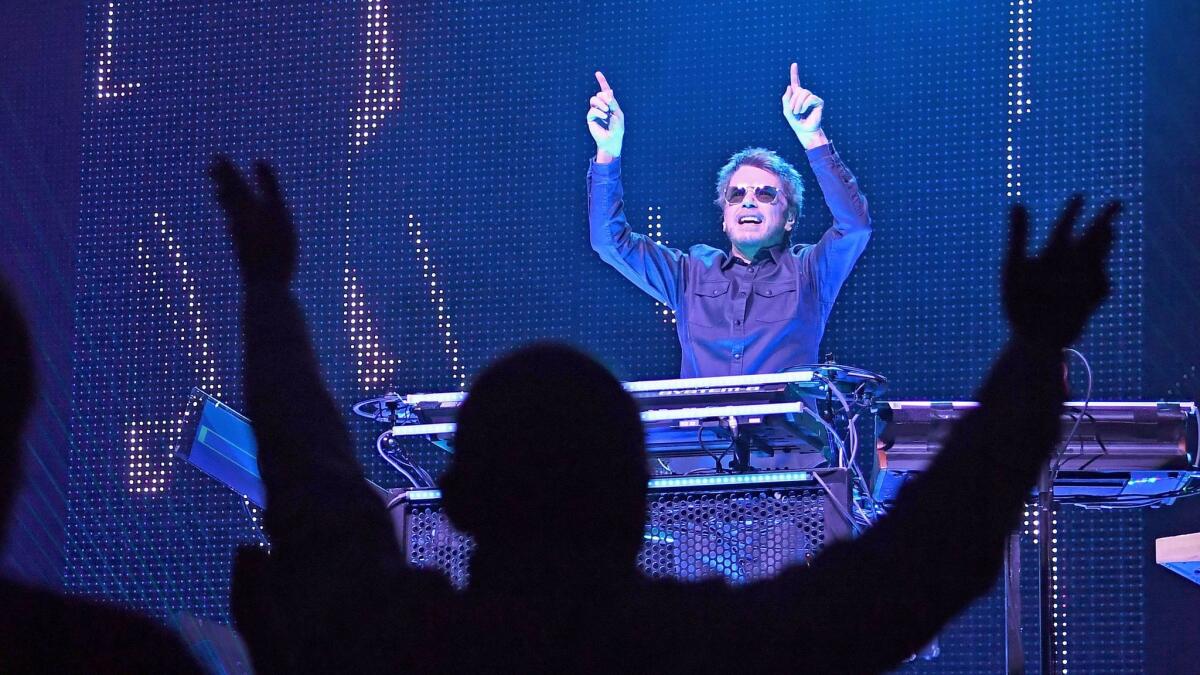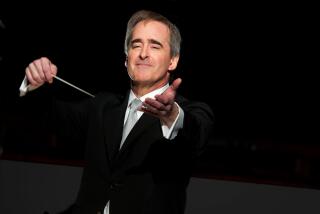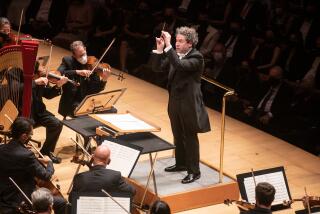Electronic music pioneer Jean-Michel Jarre’s Saturday concert will end a four-decade L.A. drought

When the French electronic composer Jean-Michel Jarre gives his first Los Angeles performance at the Microsoft Theater on Saturday night, the Grammy-nominee will end an extended absence that has stretched across 40 years and dozens of concerts around the world.
Beginning in the 1970s, Jarre, a household name in his native France, helped birth the European new age and ambient movements in electronic music with his worldwide smash “Oxygene,” his 1976 instrumental album composed using new-breed synthesizers.
He’s since issued dozens of albums and concert videos, including last year’s trilogy-concluding “Oxygene 3.” Jarre has been an outdoor performance innovator as well. Such productions have harnessed technology to create massive spectacles that predicted rave culture. His 1986 outdoor concert in Houston drew an estimated 1.2 million people.
Despite his success, Jarre had reason to skip Los Angeles on his tour itinerary: He had a strained relationship with his Oscar-winning composer-father, Maurice, who relocated to Southern California in the 1950s after divorcing Jean-Michel’s mother.
As a result, his upcoming concert has him feeling “a little bit like I’m continuing my father’s path, or if he was with me somehow,” Jarre said on the phone from Chicago earlier this week, where he’d performed the night before as part of his first North American tour.
The elder Jarre, who settled in Malibu, quickly became an in-demand composer through his scores for “Lawrence of Arabia,” “Dr. Zhivago,” “A Passage to India,” “Dead Poet’s Society,” “Ghost” and dozens more.
Jean-Michel Jarre said he was 5 when his father left, and he didn’t see him again until he was 18. Maurice Jarre died in 2009.
Describing their relationship as “difficult,” the younger Jarre, now 68, focused his energy elsewhere. “He was living in Los Angeles for 60 years, and I always, on an unconscious level, considered that it was my father’s territory.”
Since Maurice Jarre’s death, however, Jarre has been spending more time in the city. He recorded much of two recent albums, “Electronica 1” and “Electronica 2,” in L.A. studios, the former of which earned a Grammy nomination. In the process he’s worked through his feelings for his dad and for the city.
Said Jarre, “I have no problem with my father these days, and it’s very strange because my relationship with the city changed entirely. In a strange way — I spent a lot of time in L.A. in the last few years — it’s almost a little bit like part of my home.”
He added: “It’s nothing to do with music, with Hollywood, with all this. But it’s like the land itself was familiar to me.”
When he was starting out as a musician in Lyon, France, Jarre was decidedly uninterested in the familiar. His grandfather, who helped raise him, was an audio engineer and inventor who tinkered with electronics during a period in which French musique concrete composers including Pierre Schaeffer had started searching for sound within circuitry.
Although trained in the classical tradition, in the 1970s Jarre started working with some of the first commercially available synthesizers by ARP, Korg and EMS. He wasn’t alone. Across Europe, musicians including Kraftwerk, Tangerine Dream, Cluster and Brian Eno were wrestling circuitry in service of sound.
After issuing an album of library music and scoring a ballet and the film “Les Granges Brûlées,” Jarre released “Oxygene.” Featuring cosmic stereo tones that jumped from left to right speaker while soothing synthetic textures washed across the middle, the album’s six untitled movements harnessed electricity to craft entirely new sound palettes.
“If I had lived a century ago I would have used an orchestra. But today we are in the electronics age. I use the instruments of my time,” Jarre said during a 1977 interview with Britain’s “Daily Mirror.”
“Oxygene” ended up being a worldwide smash.
The critics weren’t always kind. Released during a time when punk rock was tearing through Europe, Jarre’s hit album was dismissed by some for pomposity. It wasn’t alone. A whole new instrumental movement called New Age was the yin to punk’s yang — and elicited almost as much anger.
While the punks stood onstage and banged, Jarre became obsessed with the environment and the new frontiers in live performance, passions that continue to drive each new production. Live, he works in music from his two sequels, “Oxygene 2” (parts 7-13, 1997) and “Oxygene 3” (parts 14-20, 2016), as well as classic material and remixes.
He describes his live ambition as an attempt to “express visually what I was doing from a musical point of view by creating architectural sounds and soundscapes, and creating perspectives.”
“Nowadays, a lot of people are doing it, and when I see a rock or EDM concert, I have the feeling I’m seeing something I was doing 25 years ago,” Jarre says. “And a lot of times after one or two songs you know what it is, you know? You know what the music is all about and [what] the visual is going to be.”
That’s the wrong approach. “In days where you can see almost everything on YouTube, it has to be seen to be believed,” he said.
Angelenos finally have the chance.
-
Jean-Michel Jarre
When: Saturday, May 27, 8 p.m.
Where: Microsoft Theater at L.A. Live, 777 Chick Hearn Court
Tickets: $49.50-$125
Info: www.axs.com
For tips, records, snapshots and stories on Los Angeles music culture, follow Randall Roberts on Twitter and Instagram: @liledit. Email: randall.roberts@latimes.com.
More to Read
The biggest entertainment stories
Get our big stories about Hollywood, film, television, music, arts, culture and more right in your inbox as soon as they publish.
You may occasionally receive promotional content from the Los Angeles Times.







